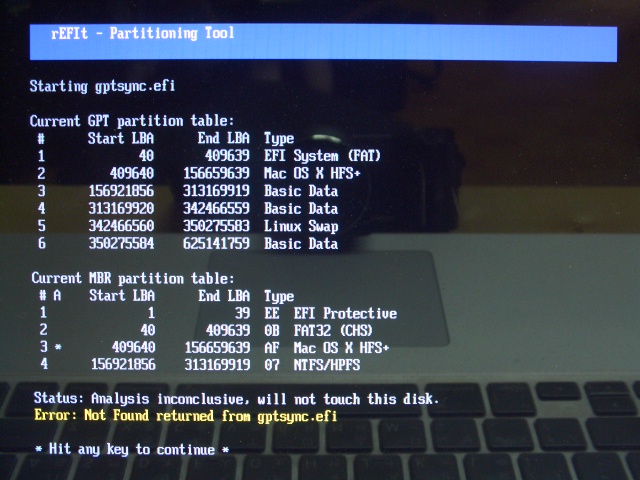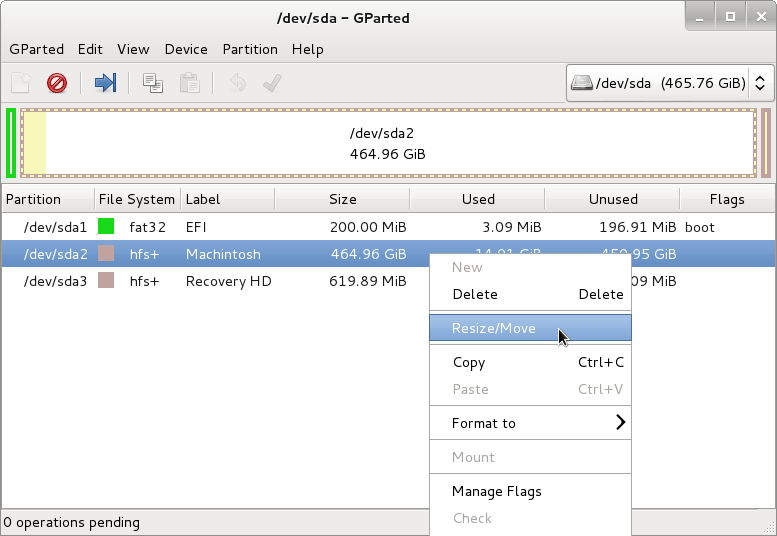

- #Partition linux mac os x mac os x#
- #Partition linux mac os x license#
- #Partition linux mac os x professional#
- #Partition linux mac os x download#
Launchctl load /System/Library/LaunchDaemons/ The following commands *may* load the necessary items to run diskutil: Single User Mode also only starts a minimal system, leaving many frameworks and daemons unloaded, including some required by diskutil. To mount the system drive as read/write, use this command: Single User Mode mounts the system volume as read-only.
#Partition linux mac os x professional#
In my professional opinion, nobody should ever run the commands listed below. I take no responsibility if in using this information, you damage your hardware or lose data. Someone in your situation should take this computer to an Apple Authorized Service Center and have the display replaced with Apple parts. I sympathize with your situation, but this is getting way beyond anything supported or recommended. Run the command: sudo mount -t msdos /dev/disk0s1 /Volumes/efi Click Continue and wait for the installation to complete. Select Show All Disks and choose your USB.
#Partition linux mac os x license#
Click through the license agreement until prompted to select the disk to use for OS installation. Open the previously downloaded macOS installer.
#Partition linux mac os x mac os x#
Mount the EFI partition at the efi mount point. Select Mac OS X Extended (Journaled) and GUID Partition Map. We can create a directory called efi within /Volumes by running the following command: mkdir /Volumes/efiģ.

On Mac OS X, mount points are typically created in /Volumes. In this case, the volume identifier of the EFI partition is disk0s1Ī mount point is a directory where a non-booted volume is mounted. The output should look something like this: /dev/disk0Ģ: Apple_HFS Macintosh HD 250.1 GB disk0s2ģ: Apple_Boot Recovery HD 650.0 MB disk0s3 Discover the volume identifier for your EFI boot partition.

To mount an EFI boot partition, follow these steps:ġ. Before you read any further, take note: altering your EFI boot partition is not supported by Apple and The Mac Admin takes no responsibility if you render your computer(s) unbootable by mounting and modifying this partition. However, the EFI partition is used as a staging area for firmware updates.” When people look to create non-standard boot environments or attempt to build a hackintosh, the first step is often mounting and modifying the EFI boot partition. Please note: Disk Drill does not provide any option to create bootable CD/DVD drives due to them becoming less popular and accessible in modern computers.Here’s the answer to another reader request…Īccording to WIkipedia, “On Apple–Intel architecture Macintosh computers, the EFI partition is initially blank and not used for booting. GParted is a free, cross platform and advanced graphical disk partition manager that works on Linux operating systems, Mac OS X and Windows. This ensures the maximum amount of data stays intact during the recovery process, and other background processes or the operating system itself do not overwrite any recoverable pieces of information. It can help you create space for installing new operating systems, reorganizing disk usage, and move data to new hard disks. Connect it to any Mac, run Disk Drill and use the "Create Boot Drive" option on the main toolbar.ĭisk Drill let's you run all its data recovery algorithms via a bootable Mac USB drive. Make sure you have an extra storage device, which is at least 2GB in size. Starting with Disk Drill 3, anyone can create a bootable Mac OS X drive in a matter of minutes. It'll make your Mac boot from USB in just a few clicks. Disk Drill is by far the most convenient and up-to-date macOS bootable file rescue solution.
#Partition linux mac os x download#
Set it aside, calm down and download a bootable data recovery app using any other computer. You can turn your computer off, remove the drive in question from the docking station, do whatever may be required to prevent any further utilization of that drive.

The initial recommendation given to anyone who lost important data and would like to proceed with the data recovery is always to stop using the drive where the data was stored as soon as possible.


 0 kommentar(er)
0 kommentar(er)
